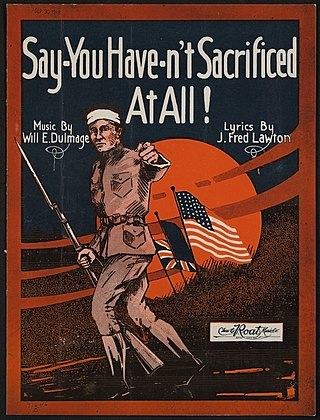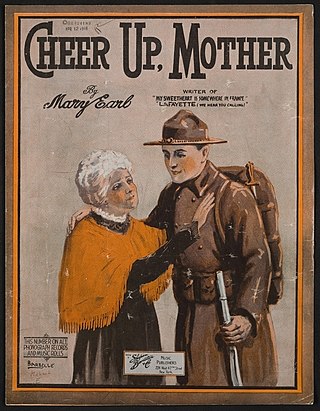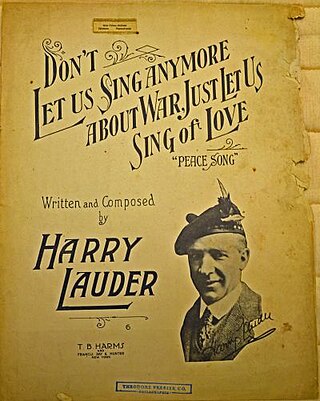
The cover has George Washington, Betsy Ross, and her helper.

"The Worst Is Yet to Come" is a World War I-era song recorded on December 12, 1918 in Camden, New Jersey. Sam M. Lewis and Joe Young provided the lyrics. Bert Grant was the composer. The song was published by Waterson, Berlin & Snyder, Inc. in New York City. Billy Murray performed the song. Artist Albert Wilfred Barbelle designed the cover art for the sheet music. On one version of the cover, a soldier is in position to bayonet a prisoner in bed.

"Say, You Haven't Sacrificed at All! (March)", also written as "Say-You Haven't Sacrificed at All!" or "Say-You Have-n't Sacrificed at All!", is a World War I era song released in 1918. Most sources have attributed the role of composer to Will E. Dulmage and lyricist to J. Fred Lawton, as it is credited on the sheet music cover. One source has their roles reversed, and another source claims both composed the music. The song was published by Chas E. Roat Music Co. of Battle Creek, Michigan. On the cover is a soldier with a head wound, pointing. Behind him are British, French, and American flags. It was written for both voice and piano.

"Cheer Up, Mother" is a World War I era song released in 1918. Mary Earl composed the music and wrote the lyrics. Shapiro, Bernstein & Co. of New York, New York published the song. Artist Albert Wilfred Barbelle designed the sheet music cover. It features a mother saying good-bye to her soldier son. It was written for both voice and piano.

"You Great Big Handsome Marine" is a World War I era song released in 1918. Most sources solely credit Harold Dixon as both the composer and lyricist, as it is listed on the sheet music. Other sources give composer credit to Dixon and lyricist credit to I. Chapman. The song was published by Dixon-Lane Publishers of St. Louis, Missouri. On the cover is a soldier standing at attention. A battleship is behind him, and planes are flying overhead. The song was written for both voice and piano.

"When a Blue Service Star Turns to Gold" is a World War I era song released in 1918. Caspar Nathan wrote the lyrics. Theodore Morse composed the music. Leo Feist, Inc. of New York, New York published the song. Featured prominently on the sheet music cover is a service star. Beneath it are soldiers charging with artillery, a tank, and a plane. It was written for both voice and piano.

"My Sweetheart Is Somewhere in France" is a World War I era song first released in 1917. Mary Earl composed the music and wrote the lyrics. Shapiro, Bernstein & Co. Inc. of New York City published the song. Elizabeth Spencer performed a version of the song that was released by the Victor record label.

'"Hello Central! Give Me No Man's Land" is a World War I era song released in 1918. Lyrics were written by Sam M. Lewis and Joe Young. Jean Schwartz composed the music. The song was published by Waterson Berlin & Snyder, Co. of New York City. Artist Albert Wilfred Barbelle designed the sheet music cover, which features a photo of Al Jolson next to a shadow of a child on the phone. Explosions in No Man's Land take up the rest of the red background. The song was written for both voice and piano. It was first introduced in the 1918 musical Sinbad.

"It's a Long, Long Way to the U.S.A " is a World War I era song released in 1917. Val Trainor wrote the lyrics. Harry Von Tilzer composed the music. The song was published by Harry Von Tilzer Publishing Company of New York, New York. It was written for both voice and piano.

"We Don't Want the Bacon " is a World War I–era song released in 1918. The lyrics were written by "Kid" Howard Carr and Harry Russell, and the music composed by Jimmie Havens. The song was published by Shapiro, Bernstein & Co. of New York City. On the cover is a soldier tearing through a large piece of bacon with his bayonet. A fearful-looking Kaiser Wilhelm II is standing on the bacon. It was written for voice and piano.

"Lorraine " is a World War I era song released in 1917. Al Bryan wrote the lyrics. Fred Fisher composed the music. It was published by McCarthy and Fisher, Inc.. André De Takacs designed the sheet music cover. It features a French soldier with his bayonet drawn in the foreground. A woman, who is a symbol of Liberty, and child look on behind him. The song was written for voice and piano.

"Tom, Dick and Harry and Jack " is a World War I era song released in 1917. Howard Johnson wrote the lyrics. Milton Ager composed the music. The song was published by Leo Feist, Inc. of New York City. Artist Henry Hutt designed the sheet music cover. It features four men in different service uniforms with an inset photo of either Jack Connors, Jr. or Bailey and Cowan. The inset photo varies by edition. It was written for both voice and piano.

"Say a Prayer for the Boys "Out There"" is a World War I era song released in 1917. Bernie Grossman wrote the lyrics. Alex Marr composed the music. It was published by Joe Morris Music, Co. of New York, New York. The sheet music cover was designed by the Starmer Brothers. It features a family praying at the dinner table. Behind them is a sentry guarding a campground of tents. There is an inset photo on the left side that varies per edition. The song was written for both voice and piano.

"Bring Back My Daddy To Me" is a World War I era song released in 1917. William Tracey and Howard Johnson wrote the lyrics. George W. Meyer composed the music. Leo Feist, Inc. of New York, New York published the song.

"And He'd Say, 'Oo-La-La! Wee-Wee!'" is a World War I era song released in 1919. Lyrics and music were written by George Jessel and Harry Ruby. William Baker arranged the song. It was published by Waterson, Berlin & Snyder, Inc. of New York, New York. The song was written for voice and piano.

"Girls of France" is a World War I era song released in 1917. Al Bryan and Edgar Leslie wrote the lyrics. Harry Ruby composed the music. The song was published by Waterson, Berlin & Snyder Co. of New York, New York. Artist Albert Wilfred Barbelle designed the sheet music cover. It features a nurse in the foreground, and soldiers marching behind her. It was written for both voice and piano.

"Don't Let Us Sing Anymore About War, Just Let Us Sing of Love " is a World War I era song released in 1918. Lyrics and music were written by Harry Lauder. It was published by T.B. Harms and Francis, Day & Hunter, Music Co. of New York, New York. The sheet music cover features a photo of Lauder with his autograph. The song was written for both voice and piano.

"The Ragtime Soldier Man" is a World War I era song released in 1912 and 1917. Irving Berlin wrote the lyrics and composed the music, basing it off his 1911 song "Alexander's Ragtime Band". The song was published by Waterson, Berlin & Snyder, Co. of New York, New York. Artist Pfeiffer designed the sheet music cover. It features a U.S. soldier holding his rifle and jumping over cannon balls. The song was written for voice and piano.

"For Your Country and My Country" is a World War I era song released in 1917. Lyrics and music were written by Irving Berlin. The song was published by Waterson, Berlin & Snyder, Co. of New York, New York. Artist Albert Wilfred Barbelle designed the sheet music cover. It features Uncle Sam playing a snare drum with an eagle on his shoulder. In the background are ships sailing, and below are troops marching. Above the title, it reads, "The Official Recruiting Song." The song was written for voice and piano, along with chords for guitar, ukulele, and banjo.

Don't Cry Frenchy, Don't Cry is a 1919 song written during World War I. The lyrics were written by Sam M. Lewis and Joe Young, and the music was written by Walter Donaldson.The song was published by Waterson, Berlin & Snyder Company in New York City.




















